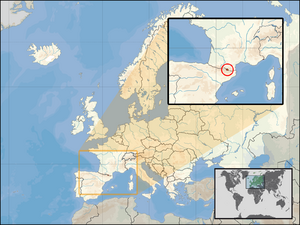Welcome to the Virtual Education Wiki ~ Open Education Wiki
Andorra: Difference between revisions
No edit summary |
(added template {{high-income}}) |
||
| (2 intermediate revisions by the same user not shown) | |||
| Line 109: | Line 109: | ||
[[Category:MISSING IMAGE]] | [[Category:MISSING IMAGE]] | ||
{{Countries-footer}} | |||
{{United Nations}} | |||
{{high-income}} | |||
Latest revision as of 20:19, 10 May 2023
by Paul Bacsich for Re.ViCa - minor updates for VISCED
For entities in Andorra see Category:Andorra
Partners situated in Andorra
None.
Andorra in a nutshell
(sourced from http://en.wikipedia.org/wiki/Andorra)
Andorra, officially the Principality of Andorra (Catalan: Principat d'Andorra), also called the Principality of the Valleys of Andorra, is a small landlocked country in southwestern Europe, located in the eastern Pyrenees mountains and bordered by Spain and France.
It has an estimated population of 84,000 (in 2008) within an area of approximately 470 km2 (181 sq mi).
Its capital is Andorra la Vella. {{#set:Has capital=Andorra la Vella}
Andorra is a prosperous country mainly because of its tourism industry and its status as a tax haven. The people of Andorra have the highest human life expectancy in the world — 85 years at birth. Andorra is the sixth smallest nation in Europe.
Andorra education policy
(overall policy)
Schools in Andorra
There are essentially three coexisting school systems in the country: French, Spanish, and Andorran.
The French government partially subsidizes education in Andorra’s French-language schools
Schools in the southern section, near Spain, are supported by the church.
The local language, Catalan, has been introduced at a school under the control of the Roman Catholic Church.
About 50% of Andorran children attend French primary schools, and the rest attend Spanish or Andorran school. In general, Andorran schools follow the Spanish curriculum, and their diplomas are recognized by Spain.
Primary school enrollment in 2003 was estimated at about 89%; 88% for boys and 90% for girls. The same year, secondary school enrollment was about 71%; 69% for boys and 74% for girls. The pupil to teacher ratio for primary school was at about 12:1 in 2003; the ratio was about 7:1 for secondary classes.
Virtually the entire adult population is literate
Higher education
The University of Andorra was established in July 1997. It has a small enrollment and mostly offers long-distance courses through universities in Spain and France - in particular UOC in Catalonia.
The majority of secondary graduates who continue their education attend schools in France or Spain. In 2003, about 8% of eligible adult students were enrolled in tertiary programs.
Andorra also has a nursing school and a school of computer science.
Private universities:
- Universitat de les Valls: Private University, in the field of dentistry
- Universitat Oberta la Salle: Private distance university offering master degrees in the field of business and computing. See for example http://www.youtube.com/watch?v=GZ9Rcw17GJo
University of Andorra
The University of Andorra (Catalan: Universitat d'Andorra) is a public institution of higher education created in the year 1997. The university comprises a school of nursing, a school of computer science, and a center for distance studies.
The university is a member of the European University Association and the Institut Joan Lluís Vives.
Education reform
Administration and finance
Quality assurance
Agència de qualitat de l'ensenyament superior d'Andorra (AQUA)
AQUA was created by Decree in 2006 to supervise the current degrees offered by the University of Andorra and new possible universities or higher education institutions.
Information society
Virtual Campuses in HE
University of Andorra has a centre for distance studies.
Lessons learnt
References
None so far.
For OER policies and projects in Andorra see Andorra/OER
